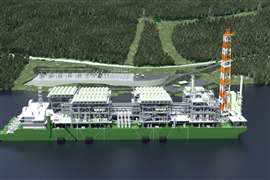Read this article in Français Deutsch Italiano Português Español
ST LNG proposes 8.4 MTPA offshore LNG export terminal
July 08, 2025

A newly filed application outlines plans for the construction and operation of a major liquefied natural gas (LNG) deepwater export terminal offshore Matagorda, Texas. The proposed ST LNG project would be located approximately 10.4 nautical miles (19.2 kilometers) off the coast in the Brazos Outer Continental Shelf Lease Block 476 (BA-476), in waters ranging from 65 to 72 feet deep.
If approved and fully developed, the ST LNG deepwater port would feature four 2.1 million tonnes per annum (MTPA) liquefaction systems, giving it a total export capacity of 8.4 MTPA. The facility would export LNG via standard LNG carriers with capacities between 125,000 and 180,000 cubic meters, with a typical load size expected to be around 146,000 cubic meters. LNG would be shipped to both Free Trade Agreement (FTA) and non-FTA countries.
Project scope: fixed and floating components
The ST LNG terminal would be developed in four construction phases and feature a combination of fixed and floating infrastructure. Key elements include:
- A 5.5-mile, 30-inch subsea lateral pipeline from shore to the connection hub
- Four gas treatment platforms
- Four liquefaction platforms
- Four accommodation and utility platforms
- Four LNG transfer platforms
- Thirty-six mooring dolphins
- Four converted LNG carriers serving as floating storage units (FSUs)
- Three tugs to assist in berthing and offloading operations
Each development phase would include the installation of one liquefaction train, along with the associated processing, utility, and transfer platforms. Phase 1, the initial stage of construction, would install three large fixed platforms, one LNG transfer platform, nine mooring dolphins, and one FSU, supported by the lateral pipeline and gas interconnection infrastructure.
Feedgas supply and pipeline interconnects
Natural gas for the ST LNG terminal would be sourced from existing infrastructure in Texas, primarily the Tres Palacios Natural Gas Storage and Trading Hub and the Williams Markham Gas Processing Plant. Feedgas would be transported through the existing Transco 30-inch pipeline, which will connect to a new 5.5-mile lateral line terminating at an interconnection hub at the deepwater port.
From the interconnection hub, four feeder pipelines will distribute gas to each liquefaction platform in the four-phase system.
ST LNG has not disclosed a specific construction or in-service timeline, but the scale and modular nature of the project suggest a phased execution strategy similar to other deepwater LNG terminals proposed in the Gulf of Mexico. Regulatory reviews and approvals are expected to follow under the Deepwater Port Act, overseen by the U.S. Maritime Administration and the U.S. Coast Guard.
If realized, ST LNG would join a growing list of offshore LNG export projects in the Gulf seeking to capitalize on abundant U.S. gas supply, global LNG demand, and reduced permitting challenges compared to land-based terminals.
MAGAZINE
NEWSLETTER

CONNECT WITH THE TEAM









